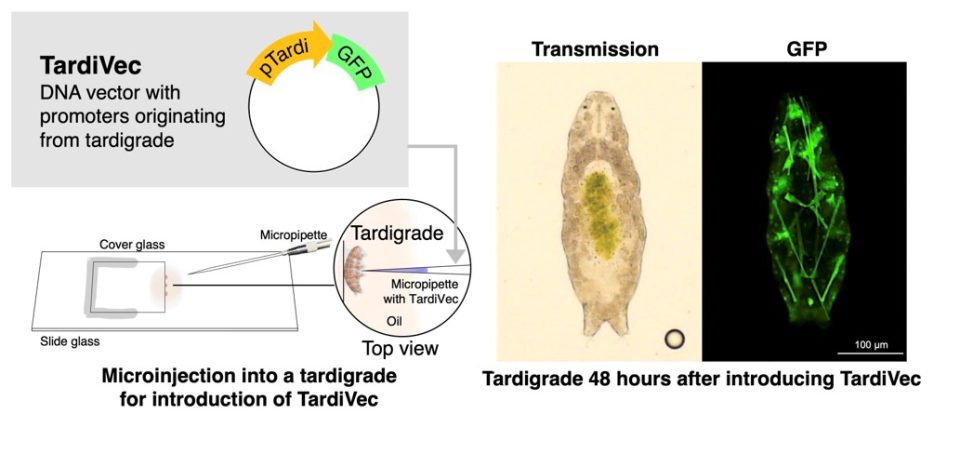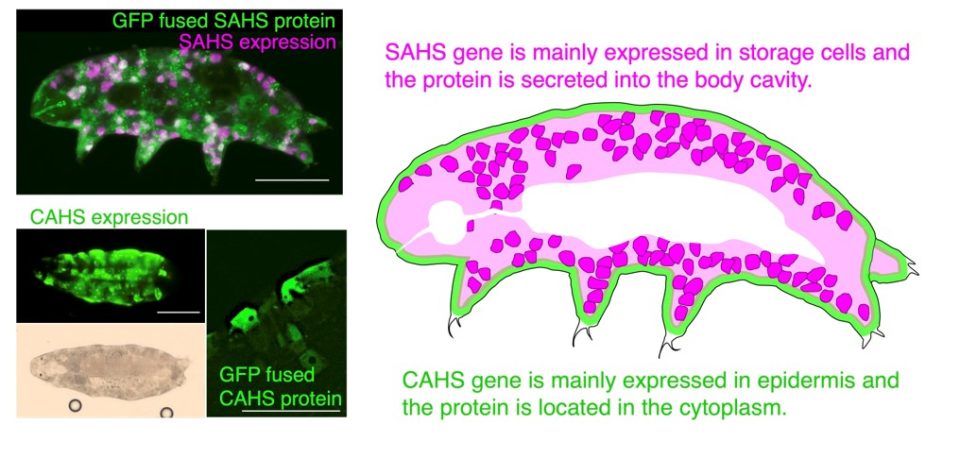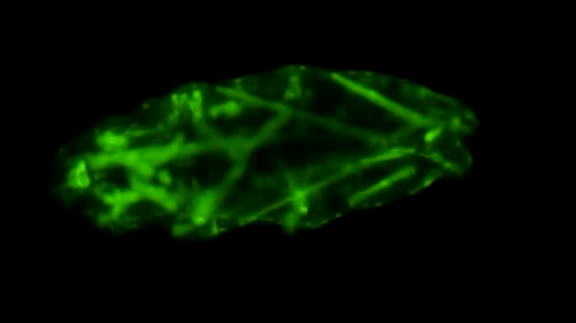 TardiVec is based on a DNA vector with promoters derived from the anhydrobiotic tardigrades. It is introduced into a tardigrade by a microinjection and the GFP fluorescence is observed after approximately 48 hours. The tardigrade expresses GFP in its muscle cells (the right panel).
TardiVec is based on a DNA vector with promoters derived from the anhydrobiotic tardigrades. It is introduced into a tardigrade by a microinjection and the GFP fluorescence is observed after approximately 48 hours. The tardigrade expresses GFP in its muscle cells (the right panel).
CREDIT: PNAS, Sae Tanaka and Kazuharu Arakawa
 The tardigrade-specific genes SAHS and CAHS are thought to be involved in anhydrobiosis. TardiVec showed that the SAHS gene is mainly expressed in storage cells floating in the body cavity, and then the SAHS protein is secreted extracellularly and spreads throughout the body. The CAHS gene was mainly expressed in cells in the epidermis, and the CAHS protein is localized in the cytoplasm.
The tardigrade-specific genes SAHS and CAHS are thought to be involved in anhydrobiosis. TardiVec showed that the SAHS gene is mainly expressed in storage cells floating in the body cavity, and then the SAHS protein is secreted extracellularly and spreads throughout the body. The CAHS gene was mainly expressed in cells in the epidermis, and the CAHS protein is localized in the cytoplasm.
CREDIT: PNAS, Sae Tanaka and Kazuharu Arakawa

Refer to the link below.
https://www.youtube.com/watch?v=ONgPRKqGJQ0
TardiVec is based on a DNA vector with promoters derived from the anhydrobiotic tardigrades. It is introduced into a tardigrade by a microinjection, and the GFP fluorescence is observed after approximately 48 hours. The injected tardigrade expresses GFP and GCaMP in the muscle.
CREDIT: Sae Tanaka and Kazuharu Arakawa
Water bears, or tardigrades, are microscopic animals that can survive extreme conditions including exposure to the vacuum of space by entering an ametabolic state called anhydrobiosis. Despite the potential value to be gained by studying the mechanisms of anhydrobiosis, the lack of genetic tools has been a major challenge in the study of tardigrades.
Sae Tanaka and Kazuharu Arakawa who are both affiliated to the Exploratory Research Center on Life and Living Systems, National Institutes of Natural Sciences, and the Institute for Advanced Biosciences, Keio University (both located in Japan), have established a new in vivo expression system which they have named TardiVec. This system is based on a DNA vector with promoters originating from the anhydrobiotic tardigrade Ramazzottius varieornatus. It enables live imaging of the dynamics of proteins and cells in live tardigrades using fluorescent proteins such as GFP.
In this study, the researchers confirmed that TardiVec enables the expression of GFP and GCaMP, a calcium indicator, in tardigrade cells. The GFP fluorescence lasted for more than 10-days, and TardiVec can be applied to several species in the class Eutardigrada. In addition, they observed tissue-specific expression of anhydrobiosis-related genes in tardigrades. This suggests that even within a tardigrade, different tissues harbor specialized mechanisms to cope with drying.
This technology for tardigrades opens up new possibilities for studying anhydrobiosis and other mechanisms of stress tolerance. The researchers hope that TardiVec will facilitate further research using tardigrades as a model organism, unlocking the secrets of their ability to withstand extreme conditions, and potentially paving the way for new ways to enhance stress tolerance in other organisms.
Reference
Journal:
Proceedings of the National Academy of Sciences
Method of research:
Experimental study
Subject of research:
Animals
Airticle title:
In vivo expression vector derived from anhydrobiotic tardigrade genome enables live imaging in Eutardigrada
Airticle publication date :
24-Jan-2023
Eurekalert! URL :
Water bears shine brightly via a novel in vivo expression vector system
Contact
Media contact :
Strategic Research Administration Office
Exploratory Research Center on Life and Living Systems (ExCELLS)
National Institutes of Natural Sciences
E-Mail: press_at_excells.orion.ac.jp
(Please replace the “_at_” with @)
Expert contacts :
Sae TANAKA
Exploratory Research Center on Life and Living Systems (ExCELLS)
National Institutes of Natural Sciences
The Institute for Advanced Biosciences, Keio University
E-Mail: sae-tanaka_at_ims.ac.jp
(Please replace the “_at_” with @)
Kazuharu ARAKAWA
Exploratory Research Center on Life and Living Systems (ExCELLS)
National Institutes of Natural Sciences
The Institute for Advanced Biosciences, Keio University
E-Mail: gaou_at_sfc.keio.ac.jp
(Please replace the “_at_” with @)

